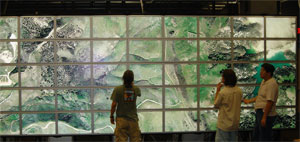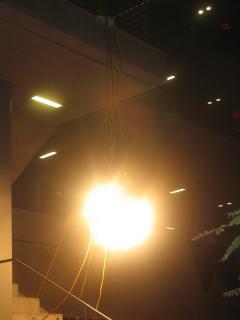

I just found a link to this UC Irvine/CalIT2 project, the HIPerWall, and I think it provides an interesting comparison to my community built display project. The "World's Highest-Resolution Display Wall", HIPerWall creates a large, arrayed high resolution display. Of course, they have better image quality, and graphics workstations and storage to handle large data sets, streamed data, and 3d graphics. But I think my project offers interesting benefits in its scaleability, its flexibility--it can be deployed anywhere, the visible public record showing what th user community has used it for, and it does not cost a thing. Rather than requiring a fixed location and purchase of hardware, a community built display can be set up anywhere with internet connectivity and laptops on hand. It is a free public resource. What the community built display does is dematerialize the display hardware. With graphics servers at home and fast enough internet connections, I think that similar content could be served to the community built display. Consider that the HIPerWall was funded with a $393,533 National Science Foundation grant, and is only available to researchers who have physical access to that lab space.
HIPerWall
news release.
The official
HIPerWall page.
For more information on the community built display, look at
roberttwomey.com.
 A community built display test with Adriene Jenick.
A community built display test with Adriene Jenick.







 I put this show together with Natalie Jeremijenko at the Armory Center for the Arts, AxS. In this image, we can see an installation of my Community Built Display project (link) which was used to display plans for an eye-level viewer, part of Natalie's amphibious architecture and OOZ projects.
I put this show together with Natalie Jeremijenko at the Armory Center for the Arts, AxS. In this image, we can see an installation of my Community Built Display project (link) which was used to display plans for an eye-level viewer, part of Natalie's amphibious architecture and OOZ projects. 


